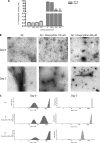Testing the therapeutic potential of doxycycline in a Drosophila melanogaster model of Alzheimer disease
- PMID: 21998304
- PMCID: PMC3308874
- DOI: 10.1074/jbc.M111.274548
Testing the therapeutic potential of doxycycline in a Drosophila melanogaster model of Alzheimer disease
Abstract
Therapies for Alzheimer disease that reduce the production of pathogenic amyloid β (Aβ) peptides have been associated with a range of unwanted effects. For this reason, alternative strategies that promote the clearance of the peptide by preventing its aggregation and deposition in the brain have been favored. In this context we have studied doxycycline, a member of the tetracycline family of antibiotics that has shown neuroprotective effects in a number of models of neurodegenerative disease. We investigated the neuroprotective potential of doxycycline in a Drosophila model of Aβ toxicity and sought to correlate any effects with the aggregation state of the peptide. We found that administration of doxycycline to Aβ42-expressing flies did not improve their lifespan but was able to slow the progression of their locomotor deficits. We also measured the rough eye phenotype of transgenic flies expressing the E22G variant of Aβ42 and showed that doxycycline administration partially rescued the toxicity of Aβ in the developing eye. We correlated these in vivo effects with in vitro observations using transmission electron microscopy, dynamic light scattering, and thioflavin T binding. We found that doxycycline prevents Aβ fibrillization and favors the generation of smaller, non-amyloid structures that were non-toxic as determined by the lack of caspase 3 activation in a neuroblastoma cell line. Our confirmation that doxycycline can prevent amyloid β toxicity both in vitro and in vivo supports its therapeutic potential in AD.
Figures






Similar articles
-
Naphthoquinone-tyrptophan reduces neurotoxic Aβ*56 levels and improves cognition in Alzheimer's disease animal model.Neurobiol Dis. 2012 Jun;46(3):663-72. doi: 10.1016/j.nbd.2012.03.005. Epub 2012 Mar 19. Neurobiol Dis. 2012. PMID: 22449754
-
Aß40 displays amyloidogenic properties in the non-transgenic mouse brain but does not exacerbate Aß42 toxicity in Drosophila.Alzheimers Res Ther. 2020 Oct 17;12(1):132. doi: 10.1186/s13195-020-00698-z. Alzheimers Res Ther. 2020. PMID: 33069251 Free PMC article.
-
PI3K activation prevents Aβ42-induced synapse loss and favors insoluble amyloid deposit formation.Mol Biol Cell. 2020 Feb 15;31(4):244-260. doi: 10.1091/mbc.E19-05-0303. Epub 2019 Dec 26. Mol Biol Cell. 2020. PMID: 31877058 Free PMC article.
-
Exploring Aβ Proteotoxicity and Therapeutic Candidates Using Drosophila melanogaster.Int J Mol Sci. 2021 Sep 28;22(19):10448. doi: 10.3390/ijms221910448. Int J Mol Sci. 2021. PMID: 34638786 Free PMC article. Review.
-
Using Drosophila amyloid toxicity models to study Alzheimer's disease.Ann Hum Genet. 2024 Sep;88(5):349-363. doi: 10.1111/ahg.12554. Epub 2024 Mar 22. Ann Hum Genet. 2024. PMID: 38517001 Review.
Cited by
-
Interdependence of nutrient metabolism and the circadian clock system: Importance for metabolic health.Mol Metab. 2016 Jan 14;5(3):133-152. doi: 10.1016/j.molmet.2015.12.006. eCollection 2016 Mar. Mol Metab. 2016. PMID: 26977390 Free PMC article. Review.
-
Suppression of Aβ toxicity by puromycin-sensitive aminopeptidase is independent of its proteolytic activity.Biochim Biophys Acta. 2013 Dec;1832(12):2115-26. doi: 10.1016/j.bbadis.2013.07.019. Epub 2013 Aug 2. Biochim Biophys Acta. 2013. PMID: 23911349 Free PMC article.
-
Phosphorylated resveratrol as a protein aggregation suppressor in vitro and in vivo.RSC Chem Biol. 2022 Jan 4;3(2):250-260. doi: 10.1039/d1cb00220a. eCollection 2022 Feb 9. RSC Chem Biol. 2022. PMID: 35360889 Free PMC article.
-
Orthologs of human disease associated genes and RNAi analysis of silencing insulin receptor gene in Bombyx mori.Int J Mol Sci. 2014 Oct 9;15(10):18102-16. doi: 10.3390/ijms151018102. Int J Mol Sci. 2014. PMID: 25302617 Free PMC article.
-
Tetracyclines downregulate the production of LPS-induced cytokines and chemokines in THP-1 cells via ERK, p38, and nuclear factor-κB signaling pathways.Biochem Biophys Rep. 2015 Nov 5;4:397-404. doi: 10.1016/j.bbrep.2015.11.003. eCollection 2015 Dec. Biochem Biophys Rep. 2015. PMID: 29124230 Free PMC article.
References
-
- Haass C., Schlossmacher M. G., Hung A. Y., Vigo-Pelfrey C., Mellon A., Ostaszewski B. L., Lieberburg I., Koo E. H., Schenk D., Teplow D. B., Selkoe D. (1992) Nature 359, 322–325 - PubMed
-
- Selkoe D. J. (2001) Physiol. Rev. 81, 741–766 - PubMed
-
- Selkoe D. J. (1991) Neuron 6, 487–498 - PubMed
-
- Abramov E., Dolev I., Fogel H., Ciccotosto G. D., Ruff E., Slutsky I. (2009) Nature Neurosci. 12, 1567–1576 - PubMed
-
- Haass C., Selkoe D. J. (2007) Nat. Rev. Mol. Cell Biol. 8, 101–112 - PubMed
Publication types
MeSH terms
Substances
Grants and funding
LinkOut - more resources
Full Text Sources
Other Literature Sources
Medical
Molecular Biology Databases
Research Materials

